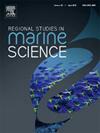Atlantic Goliath Groupers as inhabitants of mangroves on the Brazilian coast
IF 2.1
4区 环境科学与生态学
Q3 ECOLOGY
引用次数: 0
Abstract
While mangroves are essential coastal habitats in the tropics, environmental policies have often failed to protect these biodiverse estuarine environments, which has a negative impact on the ecological services they offer, while also endangering the resident species. The present study describes a population of juvenile Atlantic Grouper (Epinephelus itajara), which is a critically endangered species in Brazil, in a mangrove habitat located in close vicinity to an urban area. This description is based on the examination of biometric variables, the annual frequency of occurrence of the groupers, and a comparative analysis of similar habitats. The study aimed to devise protective measures for the conservation of the mangrove ecosystems that are considered to be essential nursery habitats for the conservation of marine species, such as E. itajara. The specimens were collected using traps, which were set in shallow, coastal habitats in the São Mateus estuary, on the eastern coast of Brazil. The length and weight of each collected specimen were recorded. A total of 148 E. itajara specimens were collected during the present study (total length: 59–365 mm; weight: 5–820 g), with significantly larger individuals being captured during the austral autumn. A significantly larger number of specimens were collected during the summer months in comparison with the winter months. The mean monthly capture rates of juvenile groupers per trap in the mangroves of eastern Brazil were higher than those reported for the state of Florida (United States). The presence of juvenile E. itajara is limited by the availability of high-quality habitats, as reflected in the distribution and abundance of the species, and the seasonal dynamics of its population in the mangrove habitats. The findings of the present study further underscore the importance of effective fishery management, and the need for long-term research to identify and protect the natural marine habitats that provide nurseries, areas of juvenile recruitment, and breeding grounds for endangered species, such as the Atlantic Goliath Grouper.
求助全文
约1分钟内获得全文
求助全文
来源期刊

Regional Studies in Marine Science
Agricultural and Biological Sciences-Ecology, Evolution, Behavior and Systematics
CiteScore
3.90
自引率
4.80%
发文量
336
审稿时长
69 days
期刊介绍:
REGIONAL STUDIES IN MARINE SCIENCE will publish scientifically sound papers on regional aspects of maritime and marine resources in estuaries, coastal zones, continental shelf, the seas and oceans.
 求助内容:
求助内容: 应助结果提醒方式:
应助结果提醒方式:


